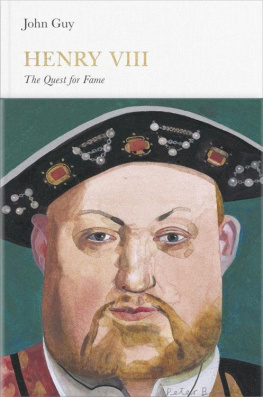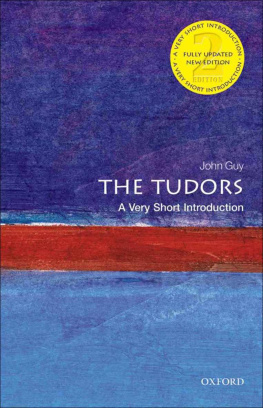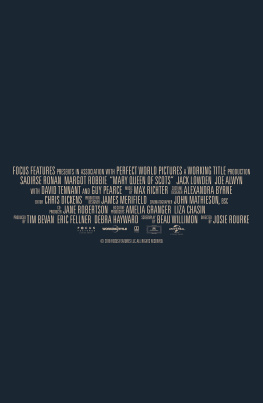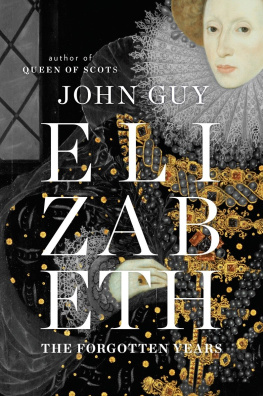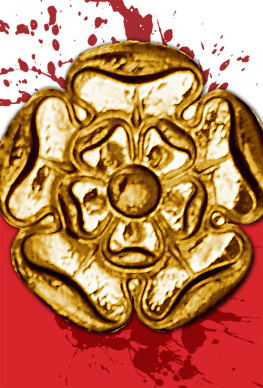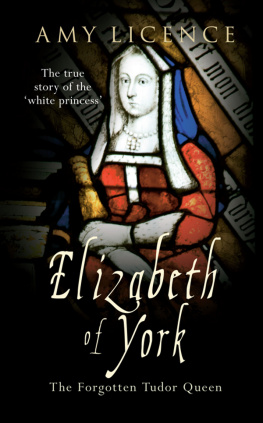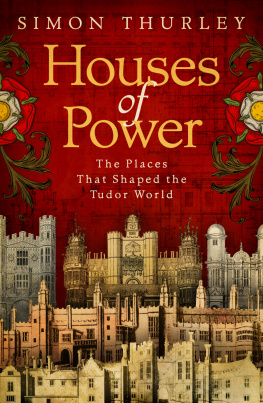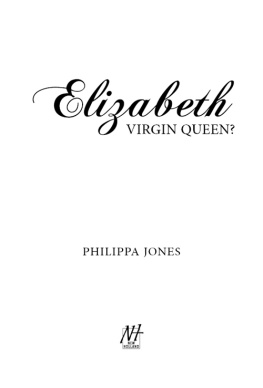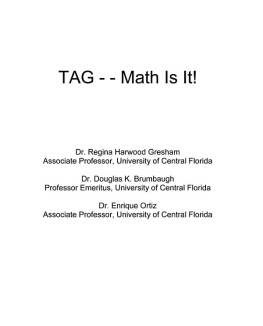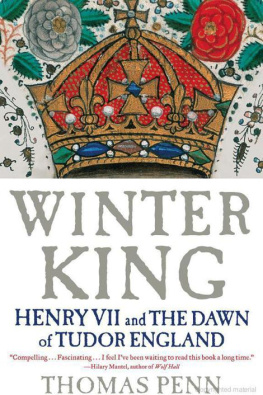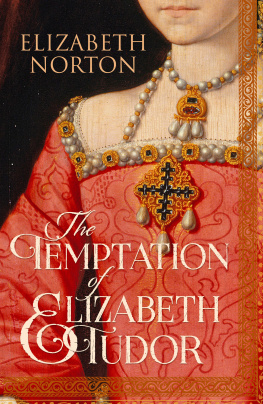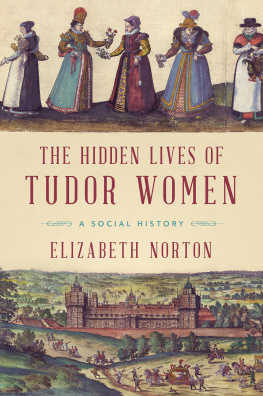GRESHAMS LAW
The Life and World of Queen Elizabeth Is Banker
JOHN GUY

First published in Great Britain in 2019 by
Profile Books Ltd
3 Holford Yard
Bevin Way
London WC1X 9HD
www.profilebooks.com
Copyright John Guy 2019
The moral right of the author has been asserted.
All rights reserved. Without limiting the rights under copyright reserved above, no part of this publication may be reproduced, stored or introduced into a retrieval system, or transmitted, in any form or by any means (electronic, mechanical, photocopying, recording or otherwise), without the prior written permission of both the copyright owner and the publisher of this book.
All reasonable efforts have been made to obtain copyright permissions where required. Any omissions and errors of attribution are unintentional and will, if notified in writing to the publisher, be corrected in future printings.
A CIP catalogue record for this book is available from the British Library.
ISBN 9781788162364
eISBN 9781782835417
CONTENTS
ACKNOWLEDGEMENTS
This book is something of a new departure for me. Commissioned by the Corporation of London and the Mercers Company through the vehicle of Gresham College for the 500th anniversary of Greshams birth, I undertook to write it on the understanding that it was always to be a biography rather than an economic history of banking or the Royal Exchange. In easing my passage towards compiling an electronic and photographic database of sources and for other help and assistance, Im especially grateful to Jane Ruddell, the Mercers Company historian, and her colleague Donna Marshall, the Companys archivist. Equally supportive were the archivists and staff of the Large Documents Room at the National Archives at Kew, the Archives Gnrales du Royaume in Brussels, the FelixArchief in Antwerp, the London Metropolitan Archives, the British Library, Lambeth Palace Library, Gonville and Caius College archives, and the art curators of the Rijksmuseum in Amsterdam and the National Portrait Gallery in London, notably Charlotte Bolland. As ever, the staff of Cambridge University Library and the superlative London Library provided exceptional help. For invaluable comments on the draft manuscript, I warmly thank Sir Roderick Floud, Sir Richard Evans, Debby Ounsted, Jane Ruddell, Ian Adamson, Charles OBrien, Giles Shilson and Michael Mainelli. Any unexpurgated mistakes are my own.
Gresham left behind a vast body of archival material, but much of it is widely scattered and his often eclectic handwriting and orthography mean than some of it is extremely time-consuming to read fully and digest. My greatest debts are to Nigel Ramsay for generously sharing with me many of the Gresham letter transcripts and related notes made by his father, the eminent economic historian G. D. Ramsay, and to Ian Adamson, the leading authority on the early history of Gresham College, who lent me copies of his doctoral dissertation as well as several published articles and unpublished typescripts, and allowed me to cite them. Alan Bryson was sponsored by Gresham College for six months to identify and transcribe a clutch of Gresham letters, mainly of the period of Edward VI and Marys reigns, and to obtain electronic copies where possible of the entire Gresham letter manuscript corpus. I am most grateful for his contributions. Assistance with the letters enabled me to concentrate during the earlier stages of research on identifying and photographing the very large quantities of financial and legal records, many of them inadequately listed, if listed at all, that contain material relevant to Gresham. Much of this information has never previously been used by historians, and some never previously seen. Its often very technical nature meant that photographing the whole was necessary before decisions could be made as to what was of the highest significance for the biography and what, necessarily, had to be left out.
Fellow scholars, hearing of my work on Gresham, have kindly sent me references or photocopies. Professor Glyn Parry generously gave me several key references to Greshams debts and Spanish adventure from the voluminous Elizabethan Exchequer Memoranda Rolls (E 159), which he was searching for a project of his own. For help with illustrations, and for generously allowing usage free of reproduction charges, Im most grateful to the officials of the Rijksmuseum, the Mercers Company, the London Metropolitan Archives, Cambridge University Library, the Masters of the Bench of the Honourable Society of Grays Inn, and the Yale Center for British Art, New Haven, Connecticut. Other images were supplied by their copyright owners with their usual speed and efficiency.
I warmly thank Peter Robinson and Natasha Fairweather, my agents, for their encouragement and support. It was Peter who first persuaded me that this was a challenge I could realistically complete. I owe an immense debt to Ed Lake, my editor at Profile, for the speed and sensitivity with which he made helpful suggestions when editing the initial draft of the manuscript and for a number of particularly valuable reflections as to why Gresham still matters and how his story could be thrown open a little more for a wider audience. Fiona Screen did a superb job as copy-editor, and for this I thank her. As ever, Im grateful to my students at Clare College, Cambridge, for engaging with my views on Gresham and for putting up during their weekly supervisions with our discussions turning round to issues of Tudor trade, banking and royal borrowing more than would usually have been the case.
My wife, the historian Julia Fox, has lived through the last three years in which Gresham has haunted our lives with a degree of tolerance for which I feel decidedly unworthy. Only rarely have her eyes glazed over on the many occasions his name has been mentioned. And at an exceptionally busy time in 2017, when an adaptation of my 2004 biography of Mary queen of Scots was being filmed for the cinema, she bailed me out by heroically sorting and filing transcripts and photocopies of the entire Gresham correspondence in chronological order and making an invaluable crib that I could use to cross-correlate with exchequer documents and other primary sources from the National Archives and elsewhere. She read and commented on every chapter of the book, some several times. Without her love and generosity, I would not have been able to finish a project involving such a large archival sweep in time to meet a submission deadline yoked to a 500th anniversary. For her help and constant support, I can never adequately thank or repay her.
London
5 March 2019
ILLUSTRATIONS
Thomas Gresham, c.1545; oil on panel by an unknown Netherlandish artist (by permission of the Mercers Company, London)
A letter from Thomas Gresham to Queen Elizabeth I, relating to money borrowed in Antwerp, 25 February 1559 [1560] (by permission of the National Archives, Kew)
The New Bourse at Antwerp; engraving from L. Guicciardini, Descrittione di tutti i paesi Bassi, Antwerp, 1588 (by permission of the Syndics of Cambridge University Library)
Greshams Royal Exchange, c.1569, engraving by Frans Hogenberg (by permission of the Rijksmuseum, Amsterdam)
Thomas Greshams house, St Franciscus, in Antwerp (authors photograph)
A ring presented by Thomas Gresham to Richard Lee ( Victoria and Albert Museum, London)
Thomas Gresham, c.1563; oil on panel by Anthonis Mor (by permission of the Rijksmuseum, Amsterdam)
Thomas Greshams wife, Anne Ferneley,


